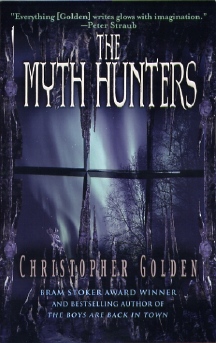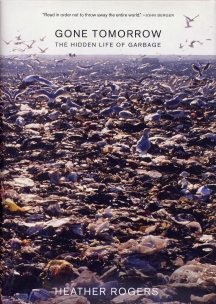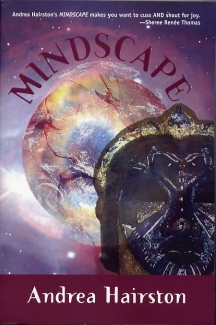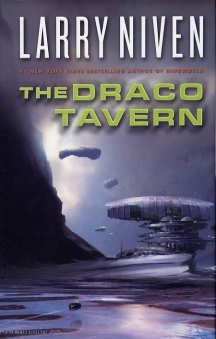|
|
|
This Just In...News from the Agony Column
|
01-28-06: Desk Jockeys of the Apocalypse |
| Science
Fiction on NPR Take a memo, folks! I'm just posting this bit of raw information for readers and listeners -- check out the new NPR report tomorrow on Weekend All Things Considered. It probably runs from 5 PM to 6 PM in your time zone, and look here tomorrow evening shortly after that for a web link to the piece, which I hope you'll all download. My original title for the report, which is on the conversation within the science fiction genre on global warming and politics in science, was "desk Jockets of the Apocalypse". The piece features exceprts from longer interviews with Kim Stanley Robinson, Bill McKibben and Doctor Bruce Ames. Tune in tomorrow and find out if the world ends with a bang, a whimper or...a memo. UPDATE: Here's the link to the NPR story. Please email this link to yourself and your friends. If we get enough hits on the email this story button, we can better lobby for more weird fiction on NPR. And weirder and weirder! |
|
01-27-06: Christopher Golden Captures 'The Myth Hunters' |
|||
One
Step Over the Line
'The Myth Hunters' begins as Oliver Bascombe, unhappy lawyer, is on the verge of getting married. Bascombe has followed the family path, the safe path, and now everything is going to turn out just fine, as it often seems just before...well,, in this case, a blizzard blows into town, bearing with it the stuff of legend and speculative fiction trilogies. In this case, that would be, erm, Jack Frost, begging for help. I know, I know, like me your mind immediately conjures up a certain actor in a certain movie. Wipe that tape, folks, or rather, pick up this novel and let Golden erase all your pre-conceived notions. He's not just very good at that, he's great at it. Just as he re-wired the vampire saga, Golden's now going about rebuilding everyone's notions of the OtherWorld, the land of Faerie, of Legends. But he's not just re-inventing the wheel, Golden is also writing a throat-gripping monster adventure, something I consider key to his appeal. You see, what’s really great about Golden is that he manages to straddle nicely between two worlds himself. Those would be the world of page-turning surreal adventure and the world page-turning mainstream adventure. Golden manages to snag the most appealing aspects of both worlds and combine them in his novels, to make the best parts of each seem new when juxtaposed within his work. Thus, his novels seem consistently exciting and surprising. When you expect something surreal, he delivers a shocking twist of events that you might find in a great mystery novel. And when you’re immersed in the mystery, he serves up a moment of surreal horror that is ever more surreal and horrific for just having popped up in the midst of his mystery. And holding the whole things together is s consistently rich prose style that stays on the right side of literature. 'The Myth Hunters' is billed on the title page as 'Book One of the Veil', and it is the first of a planned trilogy. Often this might be cause for concern, but Golden is the kind of writer who is amazingly prolific. When he promises sequels, he delivers them, on time and under budget, which considering the high quality of this novel is something worth thinking about. But while I love these trade paperbacks from Spectra -- as books they’re very nicely produced -- I've got to say that the cover image doesn't exactly jump out at me. If you weren't aware of Golden's golden record, you might miss this one, and you definitely should not. Look past the bland cover and cross the line. If you've not read Christopher Golden, then you have an ideal chance to get in on the ground floor of a series that is sure to be noteworthy. And if you have read Christopher Golden, then consider this a great excuse to head down to your independent bookseller, to browse and buy. As if you need an excuse, right? |
|
01-26-06: Here Today, A Print Interview With Heather Rogers |
||||||
'Gone
Tomorrow: The Hidden Life of Garbage'
RK: What got you interested in garbage? HR: Garbage is a unique substance in that we all make it every day, so we can all relate to it. Because of this, trash has the ability to reveal the connections between our daily lives and the often hidden horrors of larger ecological crisis. The environmental impacts of mass consumption are obscured by the way we encounter finished products on store shelves. But once a commodity becomes garbage, these consequences start becoming apparent. And what garbage reveals is that the market’s relation to nature is not one of stewarding environmental health, rather it is one of exploitation. RK: Could you talk about the things you did to research this book and movie? HR: I went to several transfer stations (where waste that’s collected at the curb is sorted for shipment to a treatment facility), recycling collection centers, landfills and incinerators. I also spent time following garbage trucks around. I talked to sanitation workers, “freelance” recyclers (many of whom are poor and homeless), and I spent time with scavengers and radical low-waste activists. My visits to the waste processing and disposal facilities were striking. These are places few people who don’t work in the waste industry ever see. To witness the scale of destruction that goes on at a landfill or incinerator is profound -- there’s so much garbage. Something else that stood out at waste disposal facilities was how on-message employees are about how environmentally benign the process is. They’re very aware of needing to avoid bad publicity, so when you’re talking to them, what they say is all very scripted. I think that reveals a lot about the contradictions these firms are trying to manage. They must simultaneously earn profits from our discards, which is inherently environmentally unsound, but they must convince the public that what they do is ecologically safe. RK: How did the world look different to you as your research progressed? HR: The most important shift was that I started to look at products on store shelves and I would see them as garbage waiting to happen. I could start to more vividly understand the connection between the finished product and the environmental fallout that comes not only from wasting, but also from the ongoing resource extraction needed to make more commodities to feed ongoing consumption. RK: How does a locale like Santa Cruz -- somewhat isolated from a major metropolis -- deal with garbage differently than, say, San Francisco? HR: Every town has its own unique system. Something that’s increasingly common everywhere, though, is the exporting of waste -- into other counties, across state lines, and even overseas. Ironically, this is fueled in part by tighter environmental controls on disposal in one’s own backyard. Due to restrictions on dumping hazardous materials, and the far greater capital outlay required to build a modern landfill with a liner and gas and leachate monitoring systems, many municipalities must send their trash to a disposal facility beyond the city limits. The problem with this is that the toxic castoffs are disproportionately dumped on communities of color that have lower levels of income and education. If we don’t stem waste before it gets made, and we only restrict its disposal, then less politically powerful communities will be saddled with the burden. RK: How did a book about the "hidden life of garbage" become a de facto history of American capitalism? HR: Once I started researching the topic, it became abundantly clear that we have so much waste because capitalism needs garbage. The neoliberal free market needs us to throw things away so that we keep buying more stuff. At every turn, the waste handling methods that are developed in this country, the way that we conceive of waste on a cultural level – these are direct products of the economic system that we live in. RK: Could you talk about how the Progressive Era was literally born in garbage? HR: There were a number of civic groups that formed in the latter decades of the nineteenth century to combat corruption in municipal government. Much of these efforts, in cities like New York, were intimately connected with the realization the ruling elite and rising middle class had that they needed to keep city streets and tenement districts clean to help maintain civic order. There’s been this connection between social control and sanitation in the modern sense since this time. In the twentieth century, the Progressive Era carried forward the project, most notably with its City Beautiful movement. There was a real resistance on the part of some ruling class elites to pay for the maintenance of public space, but once it became apparent that cleaner streets not only brought social order, but facilitated the easier flow of commodities and bodies, the role of the state in maintaining clean public space was secured. It was at this time that the role of the state as waste handler was firmly established. And, with the increasing commodification of daily life fostered by industrialization, wasting was becoming an ever-more private act. So there’s this shift that happens where wasting moves from the public sphere into the private realm, and disposal is shifted from privately funded efforts onto local government. RK: Describe what the "waste stream" is and how PR is part of this process. HR: That phrase captures the crucial role PR plays in our cultural understanding of garbage. “Waste stream” is a semantic cleansing of garbage; it makes trash sound like some relatively benign, naturally occurring substance. This is significant, because, as I argue in my book, the amount of waste America produces today is not inevitable, but is instead the outcome of choices and historical forces deeply connected to our economic system. In bringing up the issue of garbage, many people get nervous that they will be told (yet again) that it’s their fault we have so much trash, and that they need to stop being such selfish consumers. But in reality, what I found in my research was that a big reason we have ever-growing piles of rubbish is that manufacturers earn higher profits if we throw more away, and they design their products to increase disposability. Over the last fifty years there’s been a concerted and very sophisticated PR effort by manufacturers in the US to shift the responsibility for garbage off of industry’s super-toxic exploitation of the environment and onto the individual. The civic group Keep America Beautiful embodies these efforts. In 1953, KAB was founded by the Owens Illinois Glass Co. and the American Can Co.—makers of the first disposable bottle and can respectively—along with firms like Coca-Cola and Dixie Cup. From its inception, the group worked on the cultural front to shape public perceptions of mass-produced rubbish. Between 1960 and 1980 US trash output quadrupled, and to head off a backlash, KAB mounted its still active PR offensive. Under KAB’s logic, the problem was litter and the culprit was the Litter Bug. KAB’s campaign reached its most visible point in the 1970s with the now infamous public service announcements featuring the buck-skin clad Iron Eyes Cody shedding a single tear as he witnessed modern Americans carelessly tossing litter out the car window. Still powerful today, KAB has successfully convinced Americans that “Packages don’t litter, people do.”
HR: This wasn’t always the case, but today garbage has become an industry. The top three refuse handling corporations, Waste Management Inc., Republic Services, and Allied Services, control 40 percentage of the rubbish market, now worth more than $43 billion annually. Under this regime, garbage itself has become a commodity. Since firms like WMI make more profits from landfilling than all other waste company operations combined, it is in their interest to get as much garbage into the ground as possible. So, today we have the one-two punch of both manufacturers and disposal firms encouraging and facilitating wasting. RK: How and why was the "sanitary landfill" created? HR: The first modern day sanitary landfill in the US was built in Fresno, California in 1934 by a civil engineer named Jean Vincenz. Today this method of getting rid of our rubbish is the most common; 85 percent of what gets disposed of goes to sanitary landfills. This “improved” method of burying wastes became so popular because it was inexpensive and aesthetically agreeable. The role it played in shaping the way Americans perceived of their discards is key. The engineer, namely the sanitation engineer (just coming into its own as a profession about this time), was central in recasting discards as a new category of materiel: a substance that no longer had re-use value. Previously, wastes were reused extensively, even by municipalities, which in the nineteenth and well into the twentieth centuries had programs for composting, hog-feeding, and intricate sorting for recycling. During this time, household sorting of discards, and separation by paid waste handlers was routine. We often mistakenly think that sorting our wastes is a new thing, when in fact disposing of wastes mixed together is the historical anomaly. The engineer helped transform the political and public conception of rubbish, by treating discards as substances that no longer had value, and therefore no longer needed to be sorted and reused. It’s with the sanitary landfill that garbage was first systematically mixed together for disposal. Engineers helped construct household garbage as merely a technical problem, a new class of debris that just needed to be put in its proper place. RK: When and how was the concept of planned obsolescence created? HR: Understanding the genesis of planned obsolescence is key to understanding our high garbage output today. Just after WWII the US became a manufacturing powerhouse, producing the majority of the world’s goods. But, by the late 1950s, markets had grown saturated; most Americans already owned a car, and a house with all the appliances. Also, the recovering production bases in Japan and Germany were beginning to compete with US firms for what was turning into a shrinking market. At this point, the supple minds of business devised built-in obsolescence—referred to by some manufacturers at the time as “forced consumption.” Using this approach, product makers designed commodities that weren’t meant to last, which would keep people buying more. As one manufacturer proclaimed from the podium at a plastics conference in the late 1950s: “Your future is in the garbage wagon!” There’s essentially two types of built-in obsolescence, fashion and technological. Fashion obsolescence means that producers regularly market new colors and styles, whether it’s cars, clothing or dish soap. If you don’t have the latest look or the hottest brand, then you’re a loser. There are also the technological advances that render older products inferior or, sometimes, impossible to continue using. This is most apparent today with computers and cell phones. A subset of technological obsolescence is the disposable commodity—items designed to break or wear out quickly. The fact that today it’s cheaper to buy a new DVD player than to repair one that’s malfunctioning tells us that planned obsolescence has been a huge success for industry. They have managed to devise a system that’s intensely wasteful in the service of generating ongoing consumption and booming profits. It’s worth noting that not only does this mode of production externalize costs onto the environment—in the form of greater raw materials extraction to make all those commodities that then just get trashed, and in the form of disposal sites—it also represents labor that’s sacrificed to the garbage graveyard. Over the last 30 years our mountains of waste have doubled, and contained within all that rejectamenta is human labor that could have been used for very different ends. RK: How is recycling working? HR: First it’s important to say that recycling is worth doing. For example, aluminum cans made from reprocessed material require 96 percent less energy to manufacture, and reconstituted pulp uses 58 percent less water and creates 74 percent less air pollution than making paper straight from trees. Those benefits are real. Given that, it’s critical to assess the long-term viability of recycling because it’s got limits. Reprocessed materials have to compete with “virgin” resources for industrial buyers. Sometimes recycled inputs can sell, like when there are tight markets for raw materials as there has been lately with, say, steel. But if demand slumps and there’s excess metal, plastic, paper or glass floating around, it may not get bought, or it may be under priced by virgin supplies. And when there’s no market for recyclables they become garbage. Thanks to the billions of dollars in subsidies the extractive industries in the US receive (and have benefited from for generations), virgin resources can often be cheaper than recycled. This skewed market makes it harder for the recycling industry to really develop and grow. For instance, the energy bill that Congress passed last summer contains billions in tax breaks and funding for research and development for oil extraction. Instead of financing the development of more effective and efficient reprocessing methods for recyclable materials, our public funds are being channeled to the most profitable companies on the planet so they can continue exploiting virgin resources. Aside from the market constraints, and perhaps more importantly, recycling treats wastes only after they’ve already been made. It does nothing to stem rubbish production in the first place. And while the act of recycling can help stoke the imagination of solutions other than just burning or burying trash, it has also contributed to a growing sense of complacency about our wastes. Additionally, recycling has facilitated a massive scaling back in the demands of the public and environmentalists by convincing us that reprocessing alone will remedy the situation. What gets left out of the discussion are more radical calls for things like increased product durability and serviceability, which together with less packaging (by reinstituting refillable bottles, for example) would drastically cut garbage output. Recycling needs to be part of a larger plan because it’s not a viable solution on its own. RK: Could you talk about some of the green alternatives that we can pursue? HR: My book has a chapter dedicated to solutions. This part of the story is key. What I believe we need to do is struggle for social and economic justice in the context of the health of natural systems. The environmental justice movement is doing this by making the crucial connections between ecological devastation and the exploitation of human beings under the neoliberal free market system. We can no longer approach ecological issues as separate from the economic system they exist in, which has been and remains the tendency in the mainstream environmental movement. Buying products with less packaging (which scarcely exist, by the way), and committing to more diligently separating the recycling are good, but they don’t constitute a real long-range solution. Not until we address the injustices endemic to the current market system can we truly address today’s grave environmental problems. RK: Did you encounter any corporate resistance making the movie or writing the book? HR: I did encounter resistance. Some of the waste treatment facilities I tried to visit would not give me access. It took some hard work to get in. These places are off-limits in many respects, especially to journalists, because they are places we’re not supposed to see. When I did get in, I was very closely monitored; often I was assigned two or more “guides” who accompanied me the entire time, some of them even kept notes on what questions I asked and what I said. In all but one treatment facility I visited I was not allowed to take photos, and in no place was I allowed to speak to employees without my guides present. RK: Can we get the movie on DVD? HR: Yes, from AK Press (www.akpress.org). RK: What should each of us be doing every day? HR: Educating ourselves on the realities of these issues. Many people consider this a depressing prospect, but knowing the truth can be empowering, and it will foster a greater political imagination for solutions. |
|
01-25-06: Andrea Hairston 'Mindscape' & Kenneth Mark Hoover 'Fevreblau' |
||||||
Small
Press SF Lives
'Mindscape' comes from the same folks who brought you L. Timmel Duchamp's 'Alanya to Alanya', so you can bet that you've got another feminist future to hand. But 'Mindcape' looks to be a complicated bit of invention. "The twenty first century is a distant dream, an object of nostalgic worship, Paradise Lost." That's because after the Barrier arrived and divvied up the Earth, life just wasn't the same. Humanity now lives in Zones, and damn if we SF types don’t love our zones, eh? From The Twilight Zone to the Zones created by the alien visitor in the Strugatsky Brothers iconic novel 'Roadside Picnic', speculative fiction loves to dump people into Zones. In this case, the Zones are busy battling one another even though The Barrier makes that pretty damn hard. So you've got your future earth covered by an alien entity? -- machine? -- natural phenomenon? -- and a bunch of pretty damn crabby people duking it out between and around all this weirdness. Hmm, same as it ever was, no? 'Mindscape' is a big novel, some 400-plus pages with a cast of characters, a glossary and a cover that looks like something done by Abraham Ebdus from Jonathan Lethem's 'The Fortress of Solitude'. Wide screen, big questions, bigger answers and characters who have to literally save the world from an alien force as large as the world. 'Mindscape' is the work of Andrea Hairston and looks to have strolled directly out of Clarion and into the hard of Aqueduct Press. Heady stuff, and not the sort of heady stuff that you're going to find perched next to the latest book by some bestselling horror novelist.
And if that is always the case, it's one of the main reasons to read science fiction, and one of the main reasons to go beyond the confines of the military SF/*.* sequels-spinoffs/fantasy slabs that you'll typically find filling the shelves. Isn’t this exactly why you read SF? So you can experience something totally different, including covers that to my mind, might not exactly say please buy me? But take a look here; there's something well worth your time. SF is all about pioneering efforts, and here are two publishers pushing the boundaries and forcing the frontiers. Ask your bookseller. Find them online. Time to experiment. You are the experiment. |
|
01-24-06: Reader Purchase Alert; Larry Niven Visits 'The Draco Tavern' |
|||
Mark Z. Danielewski 'The Fifty Year Sword'
Until, apparently, late last year. Then, a small publisher in Belgium published a work titled 'The Fifty Year Sword'. It's being published in a run of 1,000 copies. It's illustrated by Peter van Sambeek; check out the sample I found. Bookfinder has some collector types selling copies for somewhere in the $200-$500 range. Now that's not beyond all reason, but it's certainly in ouch territory. Especially, when if you go to the HouseofLeaves Purchasing T50YS forum, you can find out how to order it from bol.com Netherlands Store for somewhere in the range of $56, delivered to your door. You're going to do this in Norwegian, so you'll need to follow the steps in the forum. It's not easy, it's not quick, and it might make your head hurt just a little. Bring up both URLs and going back and forth, you should be able to get it. I, at least got an answering email telling me I was going to get one. If and when it arrives, you, the readers, will be the first to know. In the interim, my reader tells me that, "It is a beautifully put together and weird book." It's by Mark Z. Danielewski, and it's buyable online. What else do you need to know? Once again, thanks to the reader who wrote me. This is why we all write and read this kind of stuff. These books are the keys to another dimension. |
|||
SF's
Barroom Brawl Breaks Out
While I knew all about Robinson's work, I was entirely unaware that Larry Niven had been beavering away in the same little sub-genre. So it's really nice to see that Tor, who seems to be accumulating all things Niven, is releasing, 'The Draco Tavern' (Tor /Tom Doherty Associates ; January 18, 2005 ; $24.95) a collection of all of Niven's short-short stories set in the eponymous tavern. You'll get twenty-six stories in 306 pages with an introduction laying out the setup. My calculator gives that out as allowing 11.66 pages per story. It's a pretty sweet deal, and ideal bedstand reading. The setup, then is that (to quote Niven's introduction), "say two years from when you're reading any given story," a huge spaceship piloted by space lobsters, the Chirpsiothra, pulls into orbit. Cut to a few years later, and Rich Schroeder's running a bar on earth, chock full of the hoary clichés that hang out in SFnal bars. Translator units. Floating chairs. Privacy barriers ("the cone of silence"). Seedy characters. What more can you ask than space lobsters and the cone of silence? Well, brevity, the essence of wit. And brevity you have aplenty here, as well as stories that stretch back nearly thirty years. And even better, there are a few original-to-this-collection titles to round it out. Niven tells us in his introduction that he created the Tavern tales because, "I wanted a format in which to deal with the simplest, most universal questions. God. Intelligent predators and prey. Sex, gender, reproduction. War. Human destiny. Species survival. Immortality. Ultimate computers. The destiny of the universe. Interspecies commerce. How alien minds think and how to cope with that and them." Now if you ask me, those are pretty big subjects that might seed pretty big novels. But for someone like Larry Niven, those are apparently a day in the park, the sort of thing he can deal with in eleven pages. Having read Niven since I was knee-high to a grasshopper, I can attest that he's been putting out high-quality SF that stands the test of time. Heck, some of his stories are now science fact. I remember reading his whole organleggers saga back when they'd pop up regularly in 'The Year's Best Science Fiction Stories' collections edited by Terry Carr. Damn, finding those things on the revolving racks at Zody's. Sort of puts the whole thing in perspective. What stories here will prove to be the stuff of reality some thirty years down the line? If any of them do, I can only say w00t! It means the aliens are coming to put things in perspective. They'll be following in Niven's footsteps then. He's been putting things in perspective for a long damn time. I can only hope the space lobsters have a sense of perspective when they get a look-see at our diet. I'm suggesting the ambassadors leave their bibs behind. |
|
01-23-06: Podcast Update, An Interview With Daniel H. Wilson; Tahir Shah Spends 'A Year in Casablanca: The Caliph's House' |
|||
"... a cute little baby harp seal."
The book itself is a very peculiar beast. There are portions of it which are clearly based on all the hoary old movie robot clichés you've ever heard, recast and reformatted with eye-grabbing graphics. Then, there are part deduced from those movies, and those are pretty interesting bits of speculation. Then, there are parts where Wilson talks about stuff based on his knowledge of real robots. It all fits together pretty nicely in the book. And you'll hear the same mélange in the interview as well, with lots more details on the real robots side. For example, Wilson told me about a robot that looks exactly like an irresistibly cuddly baby harp seal. Of course it has a rather sinister use. As much as I loved the fictional elements of the book -- and Wilson's re-arrangement of science fiction into facts -- I was also fascinated by Wilson's real-life work on robotics. It was the kind of interview that I thought would have fit equally well on KUSP's show Geekspeak as it does on the literary outlet. It will be broadcast this Monday, at 10:00 AM on KUSP, or you can just download the podcast, the MP3 directly from this link or get the RealAudio version. In any event, prepare to enjoy some really goofy humor. And make sure your Roomba isn’t parking itself at the base of the stairs every night. |
|||
Jinns, Goats and Gangsters
Well, now Shah is back as he spends 'A Year in Casablanca: The Caliph's House'. As before, he follows a thread from his childhood into a weird combination of traveling the hard way and the supernatural. Specifically, Shah used to travel as a child to Morocco. For all his other journeys, he still remembered those childhood vacations quite fondly. So when he gets a chance to buy a mansion in Casablanca, he leaps on it. Well, who wouldn’t? Of course, this being a book by Tahir Shah, things don’t go as swimmingly well as he might have hoped. He may be buying a huge, rambling house that was once owned by a Caliph, but he didn't realize he was also getting three people. Or the jinns, invisible spirits that were quite famously residents of Shah's new abode. Now, look, we all may or may not believe in such matter, or want to believe, but what we think and feel matters not a whit. If all your neighbors, and indeed, everyone in the countryside that surrounds you thinks you have a jinn problem, then by -- well, whatever it is that supervises jinns -- you've got a jinn problem. A problem that Shah attempts to deal with using the help of sacrificial goat (I'm wondering about the post-sacrificial clean-up, it's got to be a mess). Then there are the gangster neighbors and Shah's own unique band of bumbling ineptitude and serendipitous fortune. 'The Caliph's House' includes some really beautiful little illustrations and a glossary and we're told that Shah is still living in the Caliph's house. No word on the jinn, though. |








